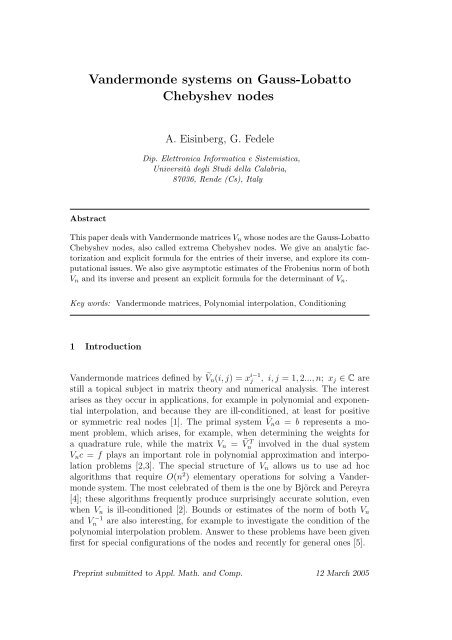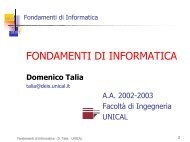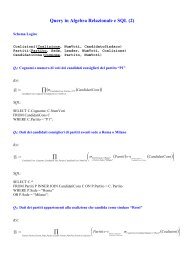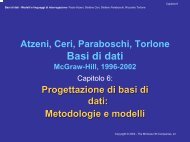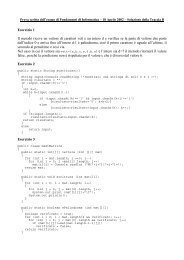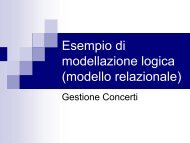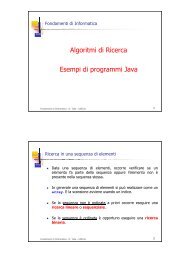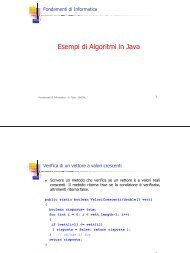Vandermonde systems on Gauss-Lobatto Chebyshev nodes
Vandermonde systems on Gauss-Lobatto Chebyshev nodes
Vandermonde systems on Gauss-Lobatto Chebyshev nodes
You also want an ePaper? Increase the reach of your titles
YUMPU automatically turns print PDFs into web optimized ePapers that Google loves.
<str<strong>on</strong>g>Vanderm<strong>on</strong>de</str<strong>on</strong>g> <str<strong>on</strong>g>systems</str<strong>on</strong>g> <strong>on</strong> <strong>Gauss</strong>-<strong>Lobatto</strong><strong>Chebyshev</strong> <strong>nodes</strong>A. Eisinberg, G. FedeleDip. Elettr<strong>on</strong>ica Informatica e Sistemistica,Università degli Studi della Calabria,87036, Rende (Cs), ItalyAbstractThis paper deals with <str<strong>on</strong>g>Vanderm<strong>on</strong>de</str<strong>on</strong>g> matrices V n whose <strong>nodes</strong> are the <strong>Gauss</strong>-<strong>Lobatto</strong><strong>Chebyshev</strong> <strong>nodes</strong>, also called extrema <strong>Chebyshev</strong> <strong>nodes</strong>. We give an analytic factorizati<strong>on</strong>and explicit formula for the entries of their inverse, and explore its computati<strong>on</strong>alissues. We also give asymptotic estimates of the Frobenius norm of bothV n and its inverse and present an explicit formula for the determinant of V n .Key words: <str<strong>on</strong>g>Vanderm<strong>on</strong>de</str<strong>on</strong>g> matrices, Polynomial interpolati<strong>on</strong>, C<strong>on</strong>diti<strong>on</strong>ing1 Introducti<strong>on</strong><str<strong>on</strong>g>Vanderm<strong>on</strong>de</str<strong>on</strong>g> matrices defined by Ṽn(i,j) = x i−1j , i,j = 1, 2...,n; x j ∈ C arestill a topical subject in matrix theory and numerical analysis. The interestarises as they occur in applicati<strong>on</strong>s, for example in polynomial and exp<strong>on</strong>entialinterpolati<strong>on</strong>, and because they are ill-c<strong>on</strong>diti<strong>on</strong>ed, at least for positiveor symmetric real <strong>nodes</strong> [1]. The primal system Ṽna = b represents a momentproblem, which arises, for example, when determining the weights fora quadrature rule, while the matrix V n = Ṽ nT involved in the dual systemV n c = f plays an important role in polynomial approximati<strong>on</strong> and interpolati<strong>on</strong>problems [2,3]. The special structure of V n allows us to use ad hocalgorithms that require O(n 2 ) elementary operati<strong>on</strong>s for solving a <str<strong>on</strong>g>Vanderm<strong>on</strong>de</str<strong>on</strong>g>system. The most celebrated of them is the <strong>on</strong>e by Björck and Pereyra[4]; these algorithms frequently produce surprisingly accurate soluti<strong>on</strong>, evenwhen V n is ill-c<strong>on</strong>diti<strong>on</strong>ed [2]. Bounds or estimates of the norm of both V nand Vn−1 are also interesting, for example to investigate the c<strong>on</strong>diti<strong>on</strong> of thepolynomial interpolati<strong>on</strong> problem. Answer to these problems have been givenfirst for special c<strong>on</strong>figurati<strong>on</strong>s of the <strong>nodes</strong> and recently for general <strong>on</strong>es [5].Preprint submitted to Appl. Math. and Comp. 12 March 2005
Polynomial interpolati<strong>on</strong> <strong>on</strong> several set of <strong>nodes</strong> has received much attenti<strong>on</strong>over the past decade [6]. Theoretically, any discretizati<strong>on</strong> grid can be used toc<strong>on</strong>struct the interpolati<strong>on</strong> polynomial. However, the interpolated soluti<strong>on</strong> betweendiscretizati<strong>on</strong> points are accurate <strong>on</strong>ly if the individual building blocksbehave well between points. Lagrangian polynomials with a uniform grid sufferfor the effect of the Runge phenomen<strong>on</strong>: small data near the center of theinterval are associated with wild oscillati<strong>on</strong>s in the interpolant, <strong>on</strong> the order2 n times bigger, near the edges of the interval, [7][8]. The best choice is touse <strong>nodes</strong> that are clustered near the edges of the interval with an asymptoticdensity proporti<strong>on</strong>al to (1 − x 2 ) −1/2 as n → ∞, [9]. The family of <strong>Chebyshev</strong>points, obtained by projecting equally spaced points <strong>on</strong> the unit circle down tothe unit interval [−1, 1] have such density properties. The classical <strong>Chebyshev</strong>grids are [10]:• <strong>Chebyshev</strong> <strong>nodes</strong>T 1 ={x k = cos• Extended <strong>Chebyshev</strong> <strong>nodes</strong>[ ]}2k − 12n π , k = 1, 2,...,n⎧⎨T 2 =⎩ x k = − cos ( ⎫2k−12n π)⎬cos ( ) , k = 1, 2,...,nπ⎭2n• <strong>Gauss</strong>-<strong>Lobatto</strong> <strong>Chebyshev</strong> <strong>nodes</strong> (extrema)T 3 ={x k = − cos[ ]}k − 1n − 1 π , k = 1, 2,...,n(1)(2)(3)In [11] it is proved that interpolati<strong>on</strong> <strong>on</strong> the <strong>Chebyshev</strong> polynomial extremaminimizes the diameter of the set of the vectors of the coefficients of all possiblepolynomials interpolating the perturbed data. Although the set of <strong>Gauss</strong>-<strong>Lobatto</strong> <strong>Chebyshev</strong> <strong>nodes</strong> failed to be a good approximati<strong>on</strong> to the optimalinterpolati<strong>on</strong> set, such set is of c<strong>on</strong>siderable interest since the norm of corresp<strong>on</strong>dinginterpolati<strong>on</strong> operator P n (T 3 ) is less than the norm of the operatorP n (T 1 ) induced by interpolati<strong>on</strong> at the <strong>Chebyshev</strong> roots [12].This paper deals with <str<strong>on</strong>g>Vanderm<strong>on</strong>de</str<strong>on</strong>g> matrices <strong>on</strong> <strong>Gauss</strong>-<strong>Lobatto</strong> <strong>Chebyshev</strong><strong>nodes</strong>. Through the paper we present a factorizati<strong>on</strong> of the inverse of such matrixand derive an algorithm for solving primal and dual system. We also giveasymptotic estimates of the Frobenius norm of both V n and its inverse and anexplicit formula for det(V n ). A point of interest in this matrix is the (relative)moderate growth, versus n, of the c<strong>on</strong>diti<strong>on</strong> number κ 2 (V n ), [13][3]. Figure 1shows the κ 2 comparis<strong>on</strong> between the <str<strong>on</strong>g>Vanderm<strong>on</strong>de</str<strong>on</strong>g> matrix <strong>on</strong> the <strong>Chebyshev</strong><strong>nodes</strong> (V n (T 1 )), <strong>Chebyshev</strong> extesa <strong>nodes</strong> (V n (T 2 )) and <strong>Gauss</strong>-<strong>Lobatto</strong> <strong>Chebyshev</strong><strong>nodes</strong> (V n (T 3 )).2
1κ 2(V n(T 3)/κ 2(V n(T 1))κ 2(V n(T 3)/κ 2(V n(T 2))0.950.90.850.80.750.70 10 20 30 40 50 60 70 80 90 100Fig. 1. Plot of the ratios κ 2(V n(T 3 ))κ 2 (V n(T 1 )) and κ 2(V n(T 3 ))κ 2 (V n(T 2 )) .n2 PreliminariesLet V n be the <str<strong>on</strong>g>Vanderm<strong>on</strong>de</str<strong>on</strong>g> matrix defined <strong>on</strong> the set of n distinct <strong>nodes</strong>X n = {x 1 ,...,x n }:V n (i,j) = x j−1i , i,j = 1,...,n (4)In [14] the authors show that the inverse of the <str<strong>on</strong>g>Vanderm<strong>on</strong>de</str<strong>on</strong>g> matrix V n ,namely W n , is:W n (i,j) = φ(n,j)ψ(n,i,j), i,j = 1,...,n (5)where the functi<strong>on</strong> ψ(n,i,j) is defined as:n−iψ(n,i,j) = (−1) i+j ∑(−1) r x r jσ(n,n − i − r), i,j = 1,...,n (6)r=0and the functi<strong>on</strong>s σ(m,s) and φ(m,s) are recursively defined as follows:3
⎧σ (m,s) = σ (m − 1,s) + x m σ (m − 1,s − 1) , m,s integer⎪⎨σ(m, 0) = 1, m = 0, 1,...(7)⎪⎩ (s < 0) ∨ (m < 0) ∨ (s > m) → σ (m,s) = 0⎧φ(m + 1,s) = φ(m,s)x m+1 −x s,m integer; s = 1,...,m⎪⎨∏φ(m + 1,m + 1) = m 1xk=1 m+1 −x k(8)⎪⎩ φ(2, 1) = φ(2, 2) = 1x 2 −x 1By (5), taking into account the (6), W n can be factorized as:where:W n = S · P · F (9)S(i,j) = (−1) i+j+1 σ(n,n + 1 − i − j), i = 1,...,n;j = 1,...,n + 1 − i(10)P(i,j) = (−1) j x i−1j , i,j = 1,...,n (11)F = diag {φ(n,i)} i=1,2,...,n(12)Note that:m∏m∑S m (x) = (x − x i ) = (−1) r σ (m,r) x m−r (13)i=1r=0S m(x ′ k ) = (−1) m+k 1, k = 1,...,m (14)φ(m,k)4
3 Main resultsWe start by noting that, for some sets of interpolati<strong>on</strong> <strong>nodes</strong>, explicit expressi<strong>on</strong>for σ and φ may be found in [15]. We c<strong>on</strong>sider the set of <strong>Gauss</strong>-<strong>Lobatto</strong><strong>Chebyshev</strong> <strong>nodes</strong> (X n = T 3 ) and give the proof of some properties useful inthe sequel.Lemma 1⎧σ(n, 2s) = (−1) s 1⌊∑n 2 ⌋ ( ) n−1 q2 ⎪⎨2q−1)( n−2 s , s = 0,..., ⌊n⌋ 2q=1(15)⎪⎩ σ(n, 2s + 1) = 0, s = 0,..., ⌈ n⌉ 2where notati<strong>on</strong>s ⌊·⌋ and ⌈·⌉ denote the floor and ceiling functi<strong>on</strong>s, respectively[16].Proof. It is easy to show that (13) can be rewritten as:whereS n (x) = 12 n−2(x − 1)(x + 1)U n−2(x) (16)U m (x) =sin [(m + 1) arccos(x)]sin [arccos(x)]is the m-order <strong>Chebyshev</strong> polynomial of the sec<strong>on</strong>d kind.But [17]:⌊ n 2 ⌋ ( )∑ n − 1U n−2 (x) = (−1) q+1 x n−2q (1 − x 2 ) q−1 (17)2q − 1q=1by substituting the (17) in (16) <strong>on</strong>e has:and, therefore, the (15) follows.⌊ n 2 ⌋ ( )∑ q∑ n − 1 qS n (x) = (−1) s xq=1 s=02q − 1)( n−2s (18)s5
Lemma 2S ′ n(x k ) = n − 12 n−2 [(−1) n+k − (−1) n δ k,1 + δ k,n](19)Proof. The (16) can be rewritten as:S n (x) = 1[(n + 1) arccos(x)]2n−2(x − 1)(x + 1)sinsin [arccos(x)]therefore, by standard algebraic manipulati<strong>on</strong>s:S ′ n(x k ) = 11 cos ( k−1n−12n−2(n − 1) cos [(n − k)π] − π)2 n−2 √ ( sin [(n − k)π]1 − cos 2 k−1n−1 π)Noting that:limk→1cos ( k−1n−1 π)√1 − cos 2 ( k−1n−1 π) sin [(n − k)π] = (−1) n (n − 1)limk→ncos ( k−1n−1 π)√1 − cos 2 ( k−1n−1 π) sin [(n − k)π] = −(n − 1)the (19) follows.By substituting the (19) in (14), <strong>on</strong>e has:⎧⎪⎨φ(n,k) =⎪⎩2 n−3n−1k = 1,n2 n−2n−1k = 2,...,n − 1(20)Lemma 3 An alternative formulati<strong>on</strong> of (15) is:σ(n, 2s) = (−1) s 1 ( ) n − s n 2 ⌊ ⌋− n − 2sn2 2s s (n − s − 1)(n − s) , s = 0, 1,..., 2(21)6
Proof. By the recurrence properties of the sec<strong>on</strong>d-kind <strong>Chebyshev</strong> polynomials[18], <strong>on</strong>e has:S n (x) − xS n−1 (x) + 1 4 S n−2(x) = 0therefore⌊ n 2 ⌋∑s=0σ(n, 2s)x n−2s −x⌊ n−12 ⌋∑s=0σ(n−1, 2s)x n−2s−1 + 1 4⌊ n−22 ⌋∑s=0σ(n−2, 2s)x n−2s−2 = 0(22)must holds. The (22) can be proved by standard algebraic manipulati<strong>on</strong>s whenn is both odd and even.By rearranging (10), (11) and (12), <strong>on</strong>e has:⎧S(i,j) = (−1) i σ(n,n + 1 − i − j), i = 1,...,n;j = 1,...,n + 1 − i⎪⎨P(i,j) = cos [ j−1n−1 π] i−1, i,j = 1,...,n(23)⎪⎩ F(i,i) = (−1) i φ(n,i)i = 1,...,nFollowing the same line in [19], the matrix P can be factorized as:P = D · U · H (24)where:⎧⎪⎨D(i,i) = 12 i−2 , i = 2,...,n(25)⎪⎩ D(1, 1) = 17
⎧U(2i − 1, 1) = ( ) ⌈ ⌉2i−3i−1 , i = 1,..., n2⎪⎨U(2i, 2j) = ( ) ⌊ ⌊ ⌋2i−1i−j , j = 1,..., n2⌋, i = j,...,n2(26)⎪⎩U(2i − 1, 2j − 1) = ( ) ⌈ ⌈ ⌉2i−2i−j , j = 2,..., n2⌉, i = j,...,n2[ ](i − 1)(j − 1)H(i,j) = cos π , i = 1,...,n, j = 1,...,n (27)n − 1If <strong>on</strong>e defines the matrix Q as:Q(i,j) = 2 n−i−1 [S · D · U] (i,j), i,j = 1,...,n (28)the (9) becomes:W n = 1n − 1 K · Q · H · F (29)whereK = diag{2 i−1 } i=1,2,...,n (30)⎧F(1, 1) = − 1 2⎪⎨F(i,i) = (−1) i , i = 2,...,n − 1(31)⎪⎩ F(n,n) = (−1) n 1 2We present here an efficient scheme for the computati<strong>on</strong> Q. It can be shownthat Q can be build by the following equalities:8
⎧Q(1, n − 2) = 2Q(i, n + 1 − i) = (−1) ii = 1, 2, ..., n⎪⎨ Q(1, n − 2j − 2) = −Q(1, n − 2j),j = 1, 2, ..., ⌈ n−42 ⌉Q(i, n + 1 − i − 2j) = −Q(i, n + 3 − i − 2j) − Q(i − 1, n + 2 − i − 2j), i = 2, 3, ..., n;j = 1, 2, ..., j ∗⎪⎩ Q(i,1) = Q(i,1)/2,i = 1, 2, ..., n(32)where⎧⎪⎨j ∗ =⎪⎩⌊ n−i2 ⌋ n even⌈ n−1−i2⌉ n odd4 The Frobenius norm of V n and W nPropositi<strong>on</strong> 1 The Frobenius norm of V n is√ n − 1‖V n ‖ F = n +2 + √ 2 (n − 1) Γ ( n + )122n−3 π Γ(n)(33)where Γ(x) is the gamma functi<strong>on</strong> [20].Proof.‖V n ‖ 2 F =n∑n∑i=1 s=1[ ( )] s − 1 2i−2cosn − 1 π (34)But9
[ ( )] s − 1 2i−2cosn − 1 π =(1 2i − 22 2i−2 i − 1)+ 1 ∑i−2( 2i − 22 2i−2 2kk=0)cos[ 2(i − 1 − k)(s − 1)n − 1]π(35)then (34) becomes:‖V n ‖ 2 F =n∑n∑i=1 s=1 k=0n∑n∑i=1 s=1i−2 ∑)(1 2i − 22 2i−2 i − 1)22 2i−2 ( 2i − 2k+[ ]2(i − 1 − k)(s − 1)cosπn − 1(36)By using the identityn∑n∑i=1 s=1( )1 2i − 2= 22 2i−2 i − 1√ n Γ ( n + 1 2π Γ(n))(37)and by standard algebraic manipulati<strong>on</strong>s the (33) follows.Propositi<strong>on</strong> 2 The Frobenius norm of W n is given by‖W n ‖ 2 F =[12(n − 1) + 22n−4β 1 (n) + 1 ]n − 1 n − 1 β 2(n)(38)whereβ 1 (n) =n∑k=1⌊ n−k∑2 ⌋ ⌊ n−k∑2 ⌋r=0s=0(−1) n+k+r+s (− 1 2n − k − r − s)σ(2r)σ(2s) (39)andβ 2 (n) =n∑k=1⌊ n−k2 ⌋∑r=0⌊ n−k2 ⌋ ∑s=01σ(2r)σ(2s) (40)2Proof. The (38) follows from standard algebraic manipulati<strong>on</strong>s.Taking into account <strong>on</strong>ly the term β 1 (n) in (38) and using the facts10
10 x 10−3 n98765432120 30 40 50 60 70 80 90 100Fig. 2. Relative error estimating ||W n || F .n∑k=1⌊ n−k∑2 ⌋ ⌊ n−k∑2 ⌋r=0q∑s=0s=0we give the following c<strong>on</strong>jecture.C<strong>on</strong>jecture 1‖W n ‖ F∼ √ 2n − 1⌊ n 2 ⌋−1 ∑p=1[·] =⌊∑n−12 ⌋ ⌊∑n−12 ⌋ n−2max (r,s)∑r=0( ) p −32 q=s − 1)(s⌊ n 2 ⌋−1 ∑q=1( n − 12p − 1s=0k=1( ) p + q −32q − 1)( n − 12q − 1[·])( p + q −32q − 1), n → ∞(41)Figure 2 shows the accuracy of the estimate of the Frobenius norm of W n interm of relative error for n in the interval [20, 100] by Eq. 41.5 The determinant of V nThe next propositi<strong>on</strong> gives the value of the determinant of V n .11
Propositi<strong>on</strong> 3det(V n ) = 2√(n − 1)n2 n(n−2) (42)Proof. By the definiti<strong>on</strong> of the <str<strong>on</strong>g>Vanderm<strong>on</strong>de</str<strong>on</strong>g> determinant we havedet(V n ) == 2 n(n−1)2∏1≤i
of both our and Björck-Pereyra algorithm. A set of experiments has been run,for n = 3 ÷ 10, 20, 30, 40, 50, 100. We have generated the right-hand sides fand b with random entries uniformly distributed in the interval [−1, 1]. Tables1 and 2 shows maximum and mean value of (43) and (44) over 10000 runs, thefracti<strong>on</strong> of trials in which the proposed algorithms (EF) give equal or moreaccurate result than Björck-Pereyra <strong>on</strong>es (BP) and also the probability thatɛ c and ɛ a is less or equal than 10nu where u = 2 −53 is the unit roundoff. Asto the computati<strong>on</strong>al cost the EF algorithms require 3n 2 + O(n) while BPalgorithms cost 2.5n 2 + O(n) flops. EF algorithms seem to perform betterthan the Björck-Pereyra <strong>on</strong>es in terms of numerical accuracy and stability asit can be seen for high value of n. Same results are obtained by computingthe approximate soluti<strong>on</strong>s ĉ and â in Matlab package and then by migratingthe output in Mathematica in order to compare it with the “exact” <strong>on</strong>e. ForMatlab code refer to Appendix A.n BP EF s.r.max mean max mean EF vs BP p(ɛ c ≤ 10nu)3 2.34-13 3.07-16 2.15-15 4.02-17 0.98 0.994 1.73-12 2.53-15 4.03-13 1.09-15 0.75 0.995 9.31-12 5.82-15 4.65-12 1.51-15 0.93 0.986 1.43-11 1.40-14 1.54-12 2.41-15 0.94 0.977 2.47-11 2.35-14 6.60-12 4.36-15 0.96 0.978 3.24-10 7.90-14 5.67-12 4.69-15 0.99 0.959 6.20-11 6.12-14 1.12-12 2.94-15 0.99 0.9610 1.56-10 1.98-13 9.00-12 6.66-15 0.99 0.9520 1.17-06 4.10-10 5.47-11 2.54-14 1.00 0.9230 2.10-03 9.79-07 2.22-09 3.86-13 1.00 0.9140 5.68+00 3.77-03 1.91-10 1.01-13 1.00 0.9250 7.61+03 1.38+01 4.04-11 9.49-14 1.00 0.90100 8.52+20 1.69+18 1.68-09 7.45-13 1.00 0.88Table 1. Dual problem. Maximum and mean value of ɛ c. Success rate of EF algorithm over 10000 runs.13
n BP EF s.r.max mean max mean EF vs BP p(ɛ a ≤ 10nu)3 1.70-13 2.90-16 5.46-13 3.26-16 0.79 0.994 1.06-10 1.33-14 3.25-11 3.99-15 0.74 0.985 3.96-11 8.87-15 7.94-13 1.32-15 0.86 0.976 6.69-11 2.68-14 3.68-12 2.57-15 0.91 0.977 2.93-11 1.66-14 4.69-12 2.91-15 0.95 0.978 6.00-11 3.52-14 2.48-12 3.15-15 0.98 0.969 9.70-11 4.33-14 6.00-12 3.16-15 0.96 0.9610 8.44-11 7.77-14 3.06-11 7.37-15 0.98 0.9520 1.12-08 3.25-12 4.49-11 1.98-14 1.00 0.9430 1.89-07 9.62-11 2.43-11 2.81-14 1.00 0.9340 1.22-05 4.26-09 2.13-10 4.33-14 1.00 0.9550 1.52-05 3.18-08 1.84-11 2.56-14 1.00 0.94100 3.88+02 1.68-01 1.71-10 7.30-14 1.00 0.94Table 2. Primal problem. Maximum and mean value of ɛ a. Success rate of EF algorithm over 10000 runs.7 C<strong>on</strong>clusi<strong>on</strong>In this paper we derived an explicit factorizati<strong>on</strong> of the <str<strong>on</strong>g>Vanderm<strong>on</strong>de</str<strong>on</strong>g> matrix<strong>on</strong> <strong>Gauss</strong>-<strong>Lobatto</strong> <strong>Chebyshev</strong> <strong>nodes</strong>. Such factorizati<strong>on</strong> allows to design anefficient algorithm to solve <str<strong>on</strong>g>Vanderm<strong>on</strong>de</str<strong>on</strong>g> <str<strong>on</strong>g>systems</str<strong>on</strong>g>. The numerical experimentsindicate that our approach is more stable compared with existing Björck-Pereyra algorithm. Starting from these theoretical results we are working witha c<strong>on</strong>jecture <strong>on</strong> discrete orthog<strong>on</strong>al polynomials <strong>on</strong> <strong>Gauss</strong>-<strong>Lobatto</strong> <strong>Chebyshev</strong><strong>nodes</strong> and its proof. The operati<strong>on</strong> count and the accuracy obtained in theexperiments <strong>on</strong> least-squares problems seems to be very competitive.Appendix A - Matlab codefuncti<strong>on</strong> c=glc(f);n=max(size(f));nf=floor(n/2);f(1)=f(1)/2;14
f(n)=f(n)/2;for i=1:nf(i)=(-1)^i*f(i);end% Matrix H%--------------------------------------------------------H=zeros(n);H(1,1:nf)=<strong>on</strong>es(1,nf);H(1:nf,1)=<strong>on</strong>es(nf,1);if rem(n,2)==0start=1;elsefor j=1:ceil(n/2)H(nf+1,2*j-1)=(-1)^(j+1);endH(:,nf+1)=H(nf+1,:)’;start=2;endfor i=2:nffor j=i:nfH(i,j)=cos(rem((i-1)*(j-1),2*n-2)*pi/(n-1));H(j,i)=H(i,j);endendfor j=1:nfif rem(j,2)==0H(nf+start:n,j)=-flipud(H(1:nf,j));elseH(nf+start:n,j)=flipud(H(1:nf,j));endendfor i=1:nif rem(i,2)==0H(i,nf+start:n)=-fliplr(H(i,1:nf));elseH(i,nf+start:n)=fliplr(H(i,1:nf));endend%--------------------------------------------------------% Matrix Q%--------------------------------------------------------Q=zeros(n);for i=1:nQ(i,n+1-i)=(-1)^i;end15
Q(1,n-2)=2;for j=1:ceil((n-4)/2)Q(1,n-2*j-2)=-Q(1,n-2*j);endfor i=2:nif rem(i,2)==0jmax=floor((n-i)/2);elsejmax=ceil((n-1-i)/2);endfor j=1:jmaxQ(i,n+1-i-2*j)=-Q(i,n+3-i-2*j)-Q(i-1,n+2-i-2*j);endendQ(:,1)=Q(:,1)/2;%--------------------------------------------------------aux=H*f;c=zeros(n,1);for i=1:nfor j=rem(n+i,2)+1:2:n+1-ic(i)=c(i)+Q(i,j)*aux(j);endendfor i=1:nc(i)=2^(i-1)*c(i);endc=c/(n-1);References[1] Gautschi, W., Inglese, G., Lower bounds for the c<strong>on</strong>diti<strong>on</strong> number of<str<strong>on</strong>g>Vanderm<strong>on</strong>de</str<strong>on</strong>g> matrix, Numer. Math., 52 (1998), 241-250.[2] Golub, G. H., Van Loan, C. F., Matrix Computati<strong>on</strong>, third ed., Johns HopkinsUniv. Press, Baltimore, MD, 1996.[3] Higham, N. J., Accuracy and Stability of Numerical Algorithms, SIAM,Philadelphia, PA, 1996.[4] Björck, A., Pereyra, V., Soluti<strong>on</strong> of <str<strong>on</strong>g>Vanderm<strong>on</strong>de</str<strong>on</strong>g> <str<strong>on</strong>g>systems</str<strong>on</strong>g> of linear equati<strong>on</strong>s,Math. of Computati<strong>on</strong>, 24 (1970), 893-903.[5] Tyrtyshnikov, E., How bad are Hankel matrices, Numer. Math., 67 (1994), 261-269.16
[6] Meijering, E., A Chr<strong>on</strong>ology of Interpolati<strong>on</strong>: From Ancient Astr<strong>on</strong>omy toModern Signal and Image Processing, Proc. of IEEE, 90 (2002), 319-342.[7] Björck, A., Dahlquist, G., Numerical Methods, Prentice-Hall, Englewood Cliffs,NJ, 1974.[8] Henrici, P., Essentials of Numerical Analysis, Wiley, New York, 1982.[9] Berrut, J. P., Trefethen, L. N., Barycentric Lagrange interpolati<strong>on</strong>, SIAM Rev.46(2004), 501-517.[10] Brutman, L., Lebesgue functi<strong>on</strong>s for polynomial interpolati<strong>on</strong> - a survey, Annalsof Numerical Mathematics, 4 (1997), 111-127.[11] Belforte, G., Gay, P., M<strong>on</strong>egato, G., Some new properties of <strong>Chebyshev</strong>polynomials, J. Comput. Appl. Math., 117 (2000), 175-181.[12] Brutman, L., A note <strong>on</strong> polynomial interpolati<strong>on</strong> at the <strong>Chebyshev</strong> extrema<strong>nodes</strong>, Journal of Approx. Theory, 42 (1984), 283-292.[13] Gautschi, W., Norms estimates for inverses of <str<strong>on</strong>g>Vanderm<strong>on</strong>de</str<strong>on</strong>g> matrices, Numer.Math., 23 (1974), 337-347.[14] Eisinberg, A., Picardi, C., On the inversi<strong>on</strong> of <str<strong>on</strong>g>Vanderm<strong>on</strong>de</str<strong>on</strong>g> matrix, Proc. ofthe 8th Triennial IFAC World C<strong>on</strong>gress, Kyoto, Japan, 1981.[15] Eisinberg, A., Fedele, G., Polynomial interpolati<strong>on</strong> and related algorithms,Twelfth Internati<strong>on</strong>al Colloquium <strong>on</strong> Num. Anal. and Computer Science withAppl., Plovdiv, 2003.[16] Knuth, D. E., The Art of Computer Programming, vol. 1, sec<strong>on</strong>d ed., Addis<strong>on</strong>-Wesley, Reading, MA, 1973.[17] Gradshteyn, I. S., Ryzhik, I. M., Table of Integrals, Series and Products, thirded., Academic Press, New York, 1965.[18] Rivlin, T. J., The <strong>Chebyshev</strong> Polynomials, John Wiley & S<strong>on</strong>s, New York, 1974.[19] Eisinberg, A., Franzé, G., Salerno, N., Rectangular <str<strong>on</strong>g>Vanderm<strong>on</strong>de</str<strong>on</strong>g> matrices <strong>on</strong><strong>Chebyshev</strong> <strong>nodes</strong>, Linear Algebra Appl., 338 (2001), 27-36.[20] Gatteschi, L., Funzi<strong>on</strong>i Speciali, UTET, 1973.[21] Wolfram, S., Mathematica: a System for Doing Mathematics by Computers,Sec<strong>on</strong>d. ed., Addis<strong>on</strong>-Wesley, 1991.17


